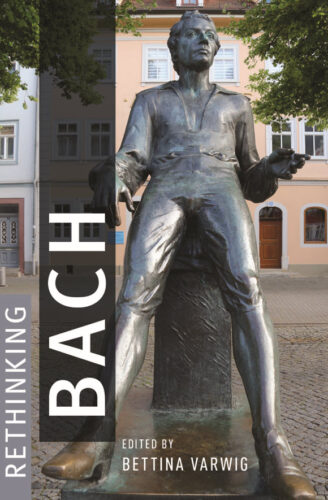by Mark Kroll
Published April 11, 2022
Rethinking Bach. Edited by Bettina Varwig. Oxford University Press, 2021. 399 Pages.
You can never think about Bach too often. This excellent book inspires the reader to do just that, and in some new and interesting ways. It is rich in historical, scholarly and analytical details and offers different approaches to, or total reevaluations of, long-held beliefs. Some are controversial and others quite provocative, beginning with the image chosen for the cover: not the traditional painting or sculpture, but rather the somewhat notorious sculpture of Bach in the small town of Arnstadt, where he served as organist from 1703-1707, that offers a full-frontal display of an obviously virile young man.
 There is one problem, however. How does a reviewer do justice to 14 chapters, each overflowing with information and insights, within the confines of the shorter book reviews of our journal? The best approach might be to list and briefly describe the contents of each chapter, and hope that this will encourage anyone who loves the music of Bach and wants to learn more about the composer and his world to read the book.
There is one problem, however. How does a reviewer do justice to 14 chapters, each overflowing with information and insights, within the confines of the shorter book reviews of our journal? The best approach might be to list and briefly describe the contents of each chapter, and hope that this will encourage anyone who loves the music of Bach and wants to learn more about the composer and his world to read the book.
It is divided into an Introduction written by editor Bettina Varwig, aptly titled “(Still) Talking about Bach,” and four large sections: “Histories,” “Bodies,” “Meanings,” and “Currents.” The first chapter, “Bach and Material Culture” by Stephen Rose, places Bach “within the vibrant consumer culture of early-eighteenth-century Leipzig,” and discusses how Bach’s compositional practice reflects his engagement with “the material characteristics of instruments.” Ellen Exner (“Rethinking 1829”) contradicts the myth that the 1829 performance of the St. Matthew Passion by Felix Mendelssohn was a new discovery, proving “that Bach’s music was never truly forgotten in Berlin,” or elsewhere, for that matter. With “Post/Colonial Bach,” Yvonne Liao views “Bach as a projected symbol of European music…an Anglo-colonial import in Hong Kong” during the colonial era and afterwards.
In Part II, Wendy Heller (“Bach and the Soprano Voice”) provides an insightful examination of the choice of voices in Bach’s choral works, arguing “that despite what we know about performance practice in Bach’s time—namely that the sacred music was composed for and sung by boys and men—Bach’s music is neither gender-free nor entirely masculine, but can exude a passionate, even extravagant sense of the feminine.” Varwig (“Embodied Invention: Bach at the Keyboard”) proposes a more “carnal” musicology of Bach, “imagining him and his knowing hands at the clavier…upending the long-standing tradition of approaching Bach as a bodiless cerebral entity,” and arguing that Bach’s music “unsettles the dualisms of mind and body, idealism and materialism.” Isabella van Elferen (“Rethinking Affect”) offers another iconoclastic challenge to the musicological citadel, writing that the so-called doctrine of the affections in Baroque music was “not widely used in the 17th- and 18th- centuries, but is rather an early 20th-century invention,” concluding that “there never was an Affektenlehre,” at least during Bach’s time, and proposing “to replace the discredited…myth [and] remove the shackles of a nonexistent doctrine.”

To begin Part III, Jeremy Begbie tackles the thorny question of “Bach and Theology.” He delves into Bach’s “attitude to and portrayal of Judaism,” disagrees with another contributor in the book, Michael Marissen, “by stating that the category of ‘anti-Judaism’ applied to John’s Gospel is surely best abandoned…[it will] do little to help us sort out what might or might not be going on in Luther, Lutheranism, and Bach.” In another somewhat iconoclastic chapter, David Yearsley (“Bach the Humorist”) reminds us that Bach, the supposedly dour and learned German composer, could also be quite funny, citing in particular the almost slapstick humor of the first Brandenburg Concerto (BWV 1046) and Bach’s secular activities at Zimmerman’s coffee house in Leipzig.
In “Rethinking Bach Codes,” Daniel R. Melamed takes issue with attempts to discover “secret codes” or “mathematical symbolism” in the works of Bach, noting that the music Handel, Mozart and other composers is not examined in this manner. John Butt (“Bach’s Works and the Listener’s Viewpoint”), addressing the question of Werktreue in Bach, explains “that any conception of musical works is historically and culturally conditioned and should not be considered distinct from specifically human concerns—a musical work is not a geological specimen after all,” and argues that “the definition of a piece of music as a ‘work’ inevitably requires the collusion of the receiving culture [and] its potential audience.”
In the final part, Derek Remeš (“Bach’s Chorale Pedagogy”) revisits Bach’s four-part Choralgesänge, the book that so many generations of students absorbed in order to learn proper voice leading and a host of other harmonic and contrapuntal skills. Remeš wonders why its “privileged status [as an instruction book]…has survived largely unchallenged for over two centuries,” when “in Bach’s circle, chorale harmonization was a more flexible and creative genre.” Joshua Rifkin (“Rethinking Editions: Mass, Missa, and Monument Culture”) writes about the challenges in creating a reliable edition of Bach’s music and performing from it, placing his discussion in the context of choosing and combining a wide range of musical, historical, and performing material found in Bach’s Mass in B minor and its earlier version, the Missa, which Rifkin himself has performed and recorded. Michael Marissen (“Bach Against Modernity”) argues forcefully that Bach was not a “modern” composer (in terms of favoring “reason above revelation…religious tolerance [and] social and political progressiveness),” that he was firmly immersed in and dedicated to traditional Christian (i.e., Lutheran) theology, including its negative views of Jews, Catholics, and Muslims, and that “every one of Bach’s vocal compositions that touches on reason rails against it as worse than useless in spiritual matters,” making his music “quintessentially antimodern.”
Michael Markham’s “Bach Anxiety: A Meditation on the Future of the Past” serves as a fitting conclusion to the book, summarizing such widely divergent views of Bach as “theological,” “mathematical,” “Romantic,” “Modernist [or] Pythagorean,” a composer who “encodes his deepest personal emotions in hidden ciphers and tragic violin wails…cares not to elevate but only to comfort…lashes out at authority,” or favors “human empathy” over “dogmatic theology.” Most importantly, Markham reminds readers and listeners that “the popular image of Bach has been flexible enough to serve each when needed.”
So will this book. I hope my goal to discuss each chapter, ever so briefly, will whet the reader’s appetite for more.
Mark Kroll is currently writing a book for Cambridge University Press about the reception of the music of Bach, Handel, and Scarlatti in Britain from 1750-1850. The Slovakian translation of his biography of J. N. Hummel will appear later this year.




